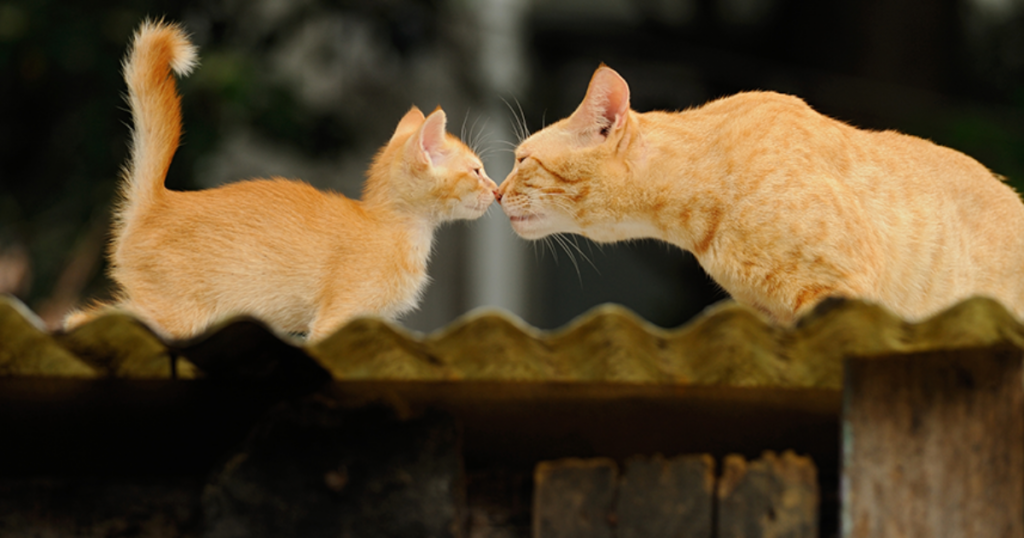Cats are often viewed as solitary, independent creatures, but anyone who has observed cats living together knows they are more social and perceptive than they might appear. One intriguing aspect of feline behavior is their capacity to learn from one another. Do cats really learn behaviors from other cats? The answer is yes, and the mechanisms behind this learning are fascinating. Let’s explore how cats observe, mimic, and adapt behaviors from their fellow felines.
SOCIAL LEARNING IN CATS
Social learning, or learning through the observation of others, is a well-documented phenomenon in the animal kingdom. While we often associate this type of learning with humans, primates, and birds, cats also engage in social learning, picking up new behaviors by watching their peers.
OBSERVATIONAL LEARNING
Observational learning in cats is evident in various everyday scenarios. For example, a new cat in a household might quickly learn to use a scratching post by watching an older cat. This form of learning is especially prominent in young kittens, who observe their mother and littermates to acquire essential skills and behaviors.
MIMICRY AND MODELING
Cats often mimic behaviors that they see other cats performing, especially if those behaviors result in positive outcomes. If one cat figures out how to open a door or access a hidden treat, it’s common for others to imitate this behavior. This mimicking is not limited to problem-solving but also extends to grooming habits, hunting techniques, and social interactions.
LEARNING THROUGH PLAY
Play is a crucial aspect of a cat’s development, and much of what cats learn through play is influenced by their peers. Kittens engage in playful fights and chases, which help them develop hunting skills and understand social boundaries. Through these playful interactions, they learn how to interact appropriately with other cats.
SOCIAL HIERARCHIES AND BEHAVIOR IMITATION
In multi-cat households, social hierarchies often emerge, influencing how behaviors are adopted and imitated. Dominant cats may establish certain behaviors that subordinate cats then follow. For instance, if the alpha cat prefers a specific sleeping spot or feeding schedule, other cats might adopt the same preferences.
GROOMING AND AFFECTION
Grooming is another behavior that cats learn from one another. Mutual grooming, or allogrooming, strengthens bonds between cats. When a cat sees another grooming itself or a companion, it may join in, reinforcing social bonds and maintaining cleanliness.
LITTER BOX TRAINING
A practical example of social learning in cats is litter box usage. New cats in a household often learn to use the litter box by observing resident cats. This observational learning can make the transition smoother and reduce the need for extensive training.
INDIVIDUAL DIFFERENCES
While social learning is evident in cats, individual differences play a significant role. Some cats are more observant and quicker to learn from their peers, while others may be more independent and less influenced by other cats’ behaviors. Factors such as personality, past experiences, and household dynamics contribute to these differences.
ENCOURAGING POSITIVE SOCIAL LEARNING
Understanding the social learning capabilities of cats can be beneficial for cat owners. Here are some tips to encourage positive social learning in multi-cat households:
- Provide Multiple Resources: Ensure there are enough resources like litter boxes, food bowls, and sleeping areas to prevent competition and stress.
- Introduce New Cats Gradually: Slow introductions help cats observe and learn from each other without feeling threatened.
- Model Desired Behaviors: Use resident cats to demonstrate desired behaviors to new cats, such as using scratching posts or being comfortable with grooming.
- Positive Reinforcement: Reward desirable behaviors in all cats to reinforce learning and maintain harmony.
Cats are not just creatures of habit; they are keen observers and learners. By understanding how cats learn behaviors from each other, cat owners can foster a more harmonious and enriched environment for their pets. From play to grooming to navigating social hierarchies, cats continuously learn from one another, enhancing their lives and those of their human companions. Whether through observation, mimicry, or play, the social learning capabilities of cats add another layer to the complex and fascinating world of feline behavior.
